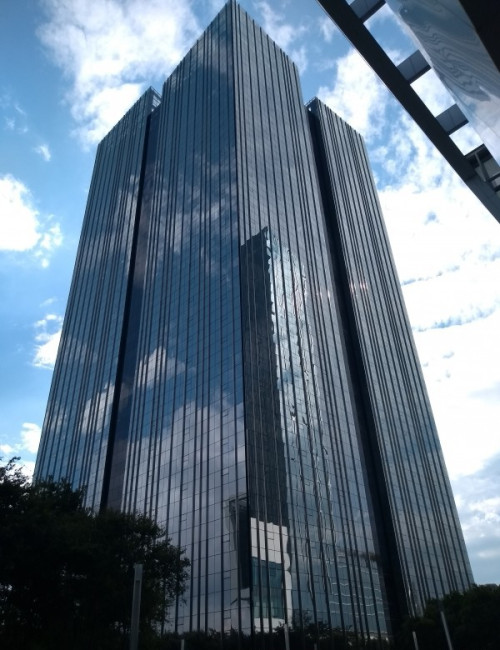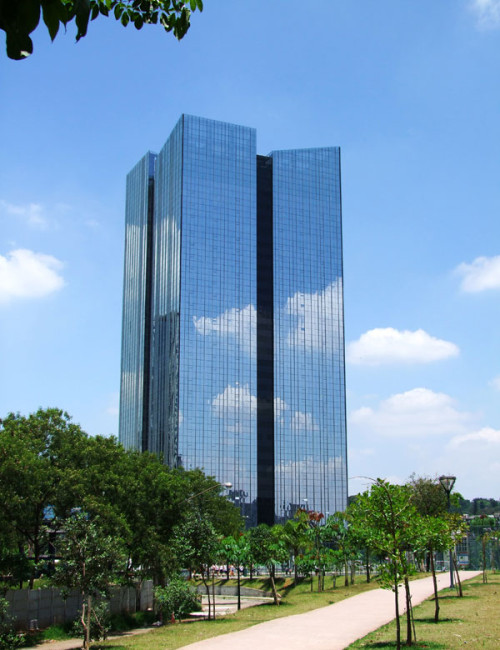Banco Real Santander Headquarters
São Paulo
This project is a redesign and replaced State Energy Company Eletropaulo Headquarters
-
Metrics
You must be a CTBUH Member to view this resource.
Official Name
Banco Real Santander Headquarters
Other Names
Torre São Paulo
Name of Complex
Type
Building
Status
Completed, 2009
Country
City
Function
A mixed-use tall building contains two or more functions (or uses), where each of the functions occupy a significant proportion of the tower's total space. Support areas such as car parks and mechanical plant space do not constitute mixed-use functions. Functions are denoted on CTBUH "Tallest Building" lists in descending order, e.g., "hotel/office" indicates hotel function above office function.
office
Structural Material
Both the main vertical/lateral structural elements and the floor spanning systems are constructed from steel. Note that a building of steel construction with a floor system of concrete planks or concrete slab on top of steel beams is still considered a “steel” structure as the concrete elements are not acting as the primary structure.
Reinforced Concrete
Both the main vertical/lateral structural elements and the floor spanning systems are constructed from concrete which has been cast in place and utilizes steel reinforcement bars.
Precast Concrete
Both the main vertical/lateral structural elements and the floor spanning system are constructed from steel reinforced concrete which has been precast as individual components and assembled together on-site.
Mixed-Structure
Utilizes distinct systems (e.g. steel, concrete, timber), one on top of the other. For example, a steel/concrete indicates a steel structural system located on top of a concrete structural system, with the opposite true of concrete/steel.
Composite
A combination of materials (e.g. steel, concrete, timber) are used together in the main structural elements. Examples include buildings which utilize: steel columns with a floor system of reinforced concrete beams; a steel frame system with a concrete core; concrete-encased steel columns; concrete-filled steel tubes; etc. Where known, the CTBUH database breaks out the materials used in a composite building’s core, columns, and floor spanning separately.
concrete
Energy Label
LEED Gold BD+C: Core and Shell
Height
135.0 m / 443 ft
Floors Above Ground
34
Floors Below Ground
2
# of Parking Spaces
2541
Tower GFA
102,200 m² / 1,100,072 ft²
Proposed
Construction Start
Completed
Material Supplier
Material Supplier refers to organizations which supplied significant systems/materials for a building project (e.g. elevator suppliers, facade suppliers, etc).
Material Supplier refers to organizations which supplied significant systems/materials for a building project (e.g. elevator suppliers, facade suppliers, etc).
You must be a CTBUH Member to view this resource.
Owner/Developer
WTorre Empreendimentos (Walter Torres Emp.)
Architect
Usually involved in the front end design, with a "typical" condition being that of a leadership role through either Schematic Design or Design Development, and then a monitoring role through the CD and CA phases.
Arquitectonica
Structural Engineer
The Design Engineer is usually involved in the front end design, typically taking the leadership role in the Schematic Design and Design Development, and then a monitoring role through the CD and CA phases.
Escritório Técnico Feitosa e Cruz Ltda; JKMF
MEP Engineer
The Design Engineer is usually involved in the front end design, typically taking the leadership role in the Schematic Design and Design Development, and then a monitoring role through the CD and CA phases.
MHA Engenharia Ltda.; TEMON Técnica de Montagens e Construções Ltda.; Thermoplan Engenharia Térmica Ltda.
Main Contractor
The main contractor is the supervisory contractor of all construction work on a project, management of sub-contractors and vendors, etc. May be referred to as "Construction Manager," however, for consistency CTBUH uses the term "Main Contractor" exclusively.
The main contractor is the supervisory contractor of all construction work on a project, management of sub-contractors and vendors, etc. May be referred to as "Construction Manager," however, for consistency CTBUH uses the term "Main Contractor" exclusively.
WTorre Empreendimentos (Walter Torres Emp.)
Material Supplier
Material Supplier refers to organizations which supplied significant systems/materials for a building project (e.g. elevator suppliers, facade suppliers, etc).
Material Supplier refers to organizations which supplied significant systems/materials for a building project (e.g. elevator suppliers, facade suppliers, etc).
About Banco Real Santander Headquarters
The building was originally designed by a separate architect as the headquarters for the State Energy Company Eletropaulo, but was abandoned after the concrete structure was completed. The structure was known for more than ten years as “the skeleton,” marring one of the most visible sites in São Paulo. In 2007 the challenging work of transforming an existing building shell into a completed design began. The result comprised of a glass tower with a single recess on each façade, creating the illusion of four slender glass buildings.
A sustainable approach was a key driver to the new design. With much of the building structure inherited, this approach focused on the use of local materials, energy efficiency, and the construction process. Rainwater and HVAC condensation is re-used for the landscape irrigation system and the high efficiency vacuum toilet system. All parking is located underground allowing almost 60% of the site area to be composed of vegetated open space. Further, the neighboring property is a public park, which was donated to the city by the construction company.
Subscribe below to receive periodic updates from CTBUH on the latest Tall Building and Urban news and CTBUH initiatives, including our monthly newsletter. Fields with a red asterisk (*) next to them are required.
View our privacy policy






